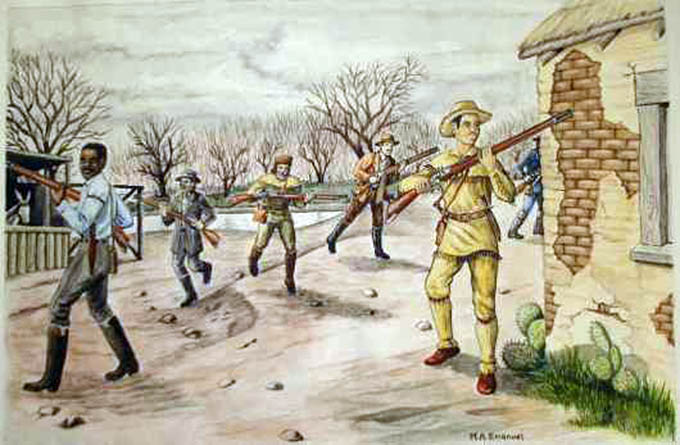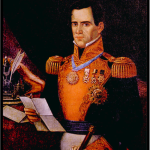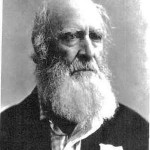The Siege of Béxar (aka Assault on San Antonio, Battle of San Antonio, Battle of Bexar, Storming of San Antonio de Bexar, Taking of Bexar) was the first major military action in the Texas revolution for independence. It occurred from October through December of 1835, with the final assault occurring Dec. 6-7, 1835.

History
San Antonio de Béxar was a city in Northern Mexico established in 1718 by the Spanish. That same year they established a mission there named San Antonio de Valero, which would later become known as the Alamo. It was a stop on El Camino Real de los Tejas, which was a trail originally created by the early indigenous peoples as a trade route. It was mapped by Spanish explorers and missionaries in the 18th century and stretched 2,500 miles from present day Mexico City, continuing through Saltillo, Monterrey, Laredo, San Antonio, and Nacogdoches, crossing the Sabine River, the border of Texas and Louisiana, and ending at Natchitoches. Camino Real, translated from Spanish, means “royal road” and it is also known as “the Kings Highway” and “the old San Antonio Road”. San Antonio de Béxar is now the city of San Antonio, located in the state of Texas in the southern United States of America.
Mexico was home to numerous people groups and, in the early 16th century, Spain conquered it and Spanish settlers began to mix with its population. In 1731, a group of 15 families from the Canary Islands settled in the Presidio San Antonio de Béxar, also known as San Fernando de Béxar. This was the first regularly organized civil government in the northernmost portion of the Mexican state of Coahuila (now the state of Texas). San Antonio de Béxar became the largest Spanish settlement in and the capital of the Spanish, later Mexican, province of Téjas.
To its north, the American colonies declared their independence from England in 1776 and the ensuing Revolutionary War lasted until 1783. Conflicts continued in the colonies until the final battle of the War of 1812, the Battle of New Orleans, in 1815. This is significant to the Siege of Béxar, as many of the men who fought in it were new citizens of Mexico from America, and the struggle for personal freedoms was fresh on their minds.
In 1810, Mexico rebelled against Spain, with a number of Americans fighting alongside Mexican citizens.
In 1821, Mexico earned its independence from Spain and, in 1824, it attempted to curtail the oppressive monarchy with the establishment of the Republic of Mexico under the Constitution of 1824.
Resisting Oppression
Worried about rebellion and recognizing the importance of the city of San Antonio de Béxar as a strategic position militarily on the Camino Real, General Santa Anna dispatched his brother-in-law, General Martín Perfecto de Cos, to occupy it. In September of 1835, General Cos established his headquarters there with the stated purpose of ending resistance in Texas and arresting dissenters of Santa Anna’s policies.
The Siege of Béxar
In October of 1835, a group of Mexican citizens of Téjas and American immigrants volunteered to serve under the command of Stephen F. Austin and Edward Burleson and lay siege to the city. Two months later, on December 5, 1835, Ben Milam and Francis W. Johnson led two divisions in a surprise attack on the city. After four days of skirmishes, on the morning of December 9, Burleson accepted the surrender of General Cos and most of his equipment and weapons. Texian casualties numbered thirty to thirty-five, while Mexican losses totaled about 150.
It was fall in Texas and winter was coming, but diaries and letters of men who were there, including William Fairfax Gray and Colonel Juan Almonte, wrote it was shirt-sleeve weather. In his diary, Samuel Maverick wrote that a norther blew in Nov. 20 and the temperatures fell to near freezing for a week, returning to mild weather. As is usual for Texas, the weather began to get colder following the end of the Siege and, February 13, 1836, the Mexican Army, located south of the Rio Grande and marching to quell the Texan rebellion, recorded an atypical blizzard, but it lasted only a day.
Neither the Texians nor the Mexicans had supplies for prisoners, so General Cos and his men were released on their pledge to not continue to oppose the Constitution of 1824. Each man was allowed to keep a rifle and limited ammunition and they agreed to leave the territory north of the Rio Grande and not return to the fight. Cos broke the pledge when he returned in March of 1836 to command a column in the attack on the Alamo.
The Surrender
 After the defeat of the Mexican Army at San Antonio de Béxar, most of the Texians returned home, but Santa Anna feared they would mount another offensive against his government and, in late February, intent on recapturing the mission, he arrived with between 1,500 and 1,800 men. This ensued with the Battle of the Alamo, culminating in its defeat and massacre of its defenders on March 6, 1836.
After the defeat of the Mexican Army at San Antonio de Béxar, most of the Texians returned home, but Santa Anna feared they would mount another offensive against his government and, in late February, intent on recapturing the mission, he arrived with between 1,500 and 1,800 men. This ensued with the Battle of the Alamo, culminating in its defeat and massacre of its defenders on March 6, 1836.
There were only two victories in the Texas Revolutionary War – the Siege of Bexar and the defeat of Santa Anna at the Battle of San Jacinto.
This site is dedicated to the men who fought in the Siege of Bexar and to their descendants – the Siege of Bexar Descendants.






Frankie Caraway says
My GGG Grandfather Gordon C Jennings fought st the battle of Bexar and died at the Alamo on March 6th 1836.
Skip Mascorro says
I was raised East of San Antonio (Upland street), the large wooded at what is now Martin Luther King Park and the Wheatley Heights Sports Complex and the Salado Creek Greenway was my wild and untamed playground.
Near what is now the Wheatley Heights Sports Complex (around 1963) I found a cannonball about the size of a tennis ball. In doing a little research I’m lead to believe that my once playground may have been the encampment and a battle area of the Siege of Bexar. A rough estimate places the site where the cannonball was found to be roughly 4 miles from the Alamo.
If there is any resource out there that could substantiate this, it would satisfy my still little boy curiosity.
Skip Mascorro
jack ekdom says
I just purchased a deed signed by Sam S Smith in 1853 in Bexar. I believe he fought in the battle there. Does anyone have any information about him and his life
Glen Jackson says
My three Great Grand Uncles, David Garner, Jacob Garner, and Isacc Garner, fought at the battle of Bexar. They survived the battle.
John McGaffey says
Glen
My name is John McGaffey. My ancestor John McGaffey married Sarah Garner, the sister of David, Isaac and Jacob Garner. John and Sarah were the early settlers of Sabine Pass and the town of Sabine.
I am wondering if you have any knowledge or records about Sarah and her descendants. Do you have any additional information on what the brothers did after the battle? Through other historical writings I have read there are a number of descendants of Sarah McGaffey still living in Southeast Texas. Just wondering if you know of any?
I hope to hear back from you.
John McGaffey
Carl Boren says
Francis White Johnson was my great x 3 grandfather. He wrote Texas and Texans which gives a good account of the Revolution.
Brilyn castanon says
Louis Castanon is my 5th great grandfather and learning this is quite interesting
Frank Ordner says
Francis White Johnson was a brother to my great great grandfaher
Drew watson says
My grandfather’s grand father was George English son of James English who fIghted in the war at bixar. My family history is awesome. His grave site is in the James English cemetery in the Davy Crockett forest. In Crockett texas.
Gerald James says
Elizabeth (Denton) English and James English were my 8th Generation Grandparents. So, … I guess we are cousins. I have a lot of relatives in the Jim English Cemetery and also, many in the Ivie Cemetery in Kennard. We have a cousin, Manuel English who wrote a book called, Texas: A Free Nation Under God. Robert English died at Goliad. Hannah English was married into the Anderson Clan. John Crockett English’s mother was somehow connected to the Crockett Clan. John Middleton wrote a book about the Moderator Regulator War of Shelby County. Joshua English and other English’s are mentioned in the book. The book is available on Google for free.
Gerald James says
After they ran Cos out of the Alamo and sent him back to Mexico. George English and the other English’s left San Antonio and went back to the Sabine Region. There was a fear that Santa Ana might come up either the Trinity or the Sabine and cut off any Arms and Soldiers that were coming in from Louisiana (Which they were). Robert English died at Goliad (Bailey’s Son, and Grandson of William English).Levi English was said to have been at the Battle of San Jacinto but he was very young at the time and not listed on the Muster Rolls. Baily built Fort English which is now called Bonham,, Texas. English Prairie is near Nogales, TX which is in the vicinity of Trevat which is where my father was born. If you are looking for more English ancestors. Look at the Ivie Cemetery as a lot of English’s are buried there. My Grandmother was Mary Jane English wife of Robert L English. They are buried there.
Mary says
One of my ancestors fought in this battle, Luis Castanon. He was also a Texas Ranger. I feel proud to know someone of my blood line fought for us.
Dianna says
I am trying to find out more of his mother Guadalupe Zertuche. Her parents names.
Dianne Gidley says
My 3 great grandfather, Thomas. Birtrong, died during the Seige of Bexar. He died there at 79 years old.
Richard Lynn Lewis says
My Name is RICHARD LEWIS . My 1811 – 1885 G-G-Grand-Pa JACOB LEWIS was at DEC 5 to DEC 10 , 1835 SIEGE OF BEXAR . He DID Survive the Battle . JACOB LEWIS was in WILLIS H. LANDRUM ‘s Company or Platoon . Jacob Lewis Did Receive a 640 Acre Land Grant from the Republic of Texas . . He Lived in Nacogdoches along LA NANA CREEK and Died in 1885 . He is Buried in the OAK Grove Cemetery near Down Town Nacogdoches .
Kelly Tumlinson says
My great uncle George Tumlinson survived the battle at Bexar and later perished as part of the immortal 32 at the Alamo.In our family,we remember him and we are immensely proud of him.